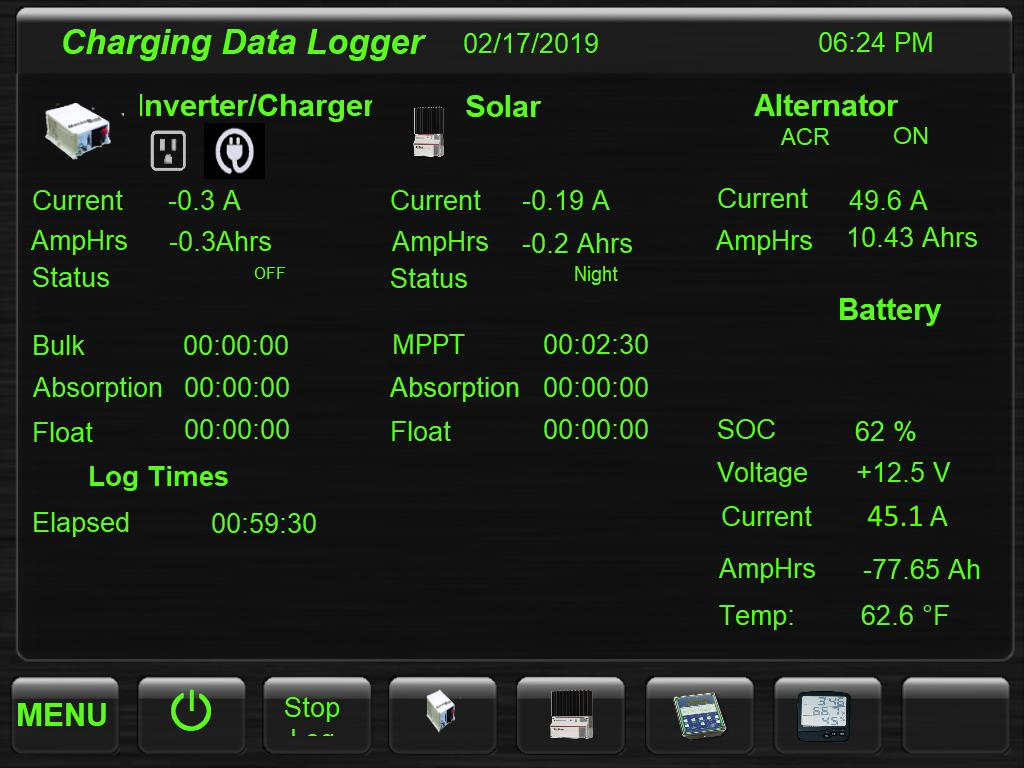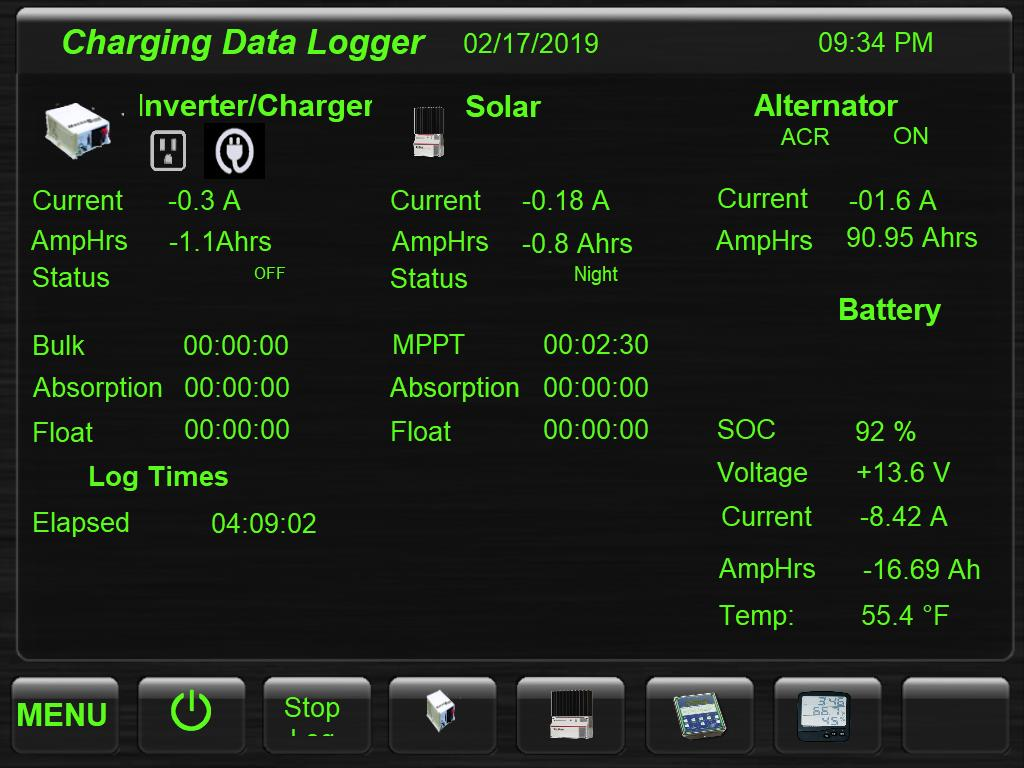This question always comes up, how long does it take to charge up my house battery while driving, with solar or for that matter shore power. We always hear a lot of different answers.. The answers vary so much, for a lot of reasons, the size of the battery bank, how far it was discharged, how do you determine it is charged. So, I thought that maybe I would see if I could throw some data on the topic.
It just so happens that I like RV’s specifically my sportsmobile, I am also an engineer and love to collect data. And more importantly I have and installed and written programs that help me collect that data. It just seemed that I could naturally just try to collect some of this data and present it here.
The test platform will be my 2004 Sportsmobile V10 with a 140-amp alternator. I run a 2 awg cable from the starting battery back to the Blue Sea 7622 ACR. The ACR attaches to the Lifeline 4D battery, via 0/4 cable that runs from the Magnum MS2000 inverter/charger. I augment those charging systems with solar. I have a Morningstar Tristar TS-MPPT -60 solar controller, connected to two 180 Watt Grape Solar panels. I have a Pentametric battery monitor by Bogart Engineering, that allows me to monitor the House battery SOC, voltage, current, temp and amp hours. It also monitors current and amp hours to/from inverter/charger, current and amp hours from solar, and lastly the battery voltage of the starting battery.
Shore Power
The first run will be a shore power charge through my Magnum MS2000 inverter/charger, it is also equipped with the Magnum BMK or Battery Monitor Kit and has the ME-ARC Remote. The charger is set to limit at 60 Amps, this would be a point 3 C rate, A little more robust than the typical point 2 C, but not as aggressive as the point 4 C rate. Another big thing to check is what does your charger use to determine that absorption is done and were moving to the float stage. Many times, this may be a combination of things, such as a absorption timer, current going into the battery. A formula used by most battery manufactures is c/20 rate, C being the total amp hours in the batter bank. In my setup up I have the optional Magnum Battery Monitor Kit installed, so my charge will end based on SOC. The BMK meter will use current, time, amps going in and out and battery efficiency to determine 100% SOC.
The following graph has the most pertinent data on it. The vertical axis is from -100 to 120, the horizontal axis is timed based 30 second increments. We have SOC, volts, current, amp-hours, and temperature for the house battery. We than have the inverter/charger current, amp-Hours, charger State, and outside temperature. I have also put on the graph the times in each charger state, bulk, absorption and float.
SOC – Darker Blue: you will see the SOC move from 50 to finally hitting 100% after the charge cycle is done.
Volts – Orange: With the scale of this graph it is hard to see, but the voltage will transition slowly up to the absorption voltage during the bulk phase, stay at absorption level until transitioning back to float.
Battery Current – Gray: This is the actual current that goes into the battery
Battery Amp Hours- Yellow: This is the Battery amp hour level through out
the run, in this case it should start at -100 and slowly move up to zero.
Battery Temp – Light Blue: The temperature did not fluctuate to much during this cycle, 32°F to 41°F.
Inverter/Charger Current – Green: This is the current coming out of the charger, it hits 60 amps during the bulk phase
And transition lower through out absorption.
The difference between Charger Current and Battery Current would be the power that is being consumed by various loads in the van.
Inverter/Charger Amp Hours- Purple: This will start at zero and continue to move up
Outside Temp- Burnt Orange: Not much to see here it stays between 29.7°F and 31.5 °F

The first charging stage is bulk, bulk is traditionally considered a constant current stage. This means the current will be set to the maximum setting, in this example that is 60 amps. The time that the charger remains in bulk, will be determined by the discharge level, size of the battery and type of battery and more importantly what type of battery the charger is programmed for.

My Charger is set for AGM 1, so I have a absorption setting of 14.3 and a float voltage of 13.1, and Equalization voltage of 15.5. We should be in the bulk phase until the voltage reaches 14.3 volts + temperature compensation. In our raw data example, we see absorption mode reached at 68-69% SOC 14.6-14.9 volts,

Below is a screenshot of my logging program, I have just hit the start button, battery SOC is 50%

Here you can see that the charger is on and that we are in the bulk phase, charger putting out 58.6 Amps

Thirty seven minutes into the run we are at 67%

A quick look at the Inverter/Charger program to check the Transformer and FET Temp, I might need to add these to the data collected.

As you can see, we have moved into absorption phase

Very close to topping this off.


As you can see, we remained in the absorption phase for quite a while. This phase takes a long time because it a constant voltage phase, where the current is reduced as we get closer to full capacity. Most chargers use some algorithm of current to determine when the enter the float phase. One thing to be careful is that many chargers have the capability to limit the time in absorption by time. It is always good to make sure that if you have a timeout that it will be long enough to cover your expected charge time. If my charger was limited to 4 hours in absorption, it would not have charged the battery to full capacity.
Solar Power
The next charge source I thought I would check out was solar. I live in the PNW so solar in February is not going to be a big producer. I did see that we had a partially sunny day coming so I went for it. The van was sitting at 67% SOC when we started to get some sunlight, my Tristar MPPT controller is also a 3-stage charger like the Magnum MS2000. Instead of calling it the bulk phase, it is considered the MPPT phase, the absorption and float phases would be the same as the Magnum. The difference with a solar charger is that the bulk phase is not really a constant current phase, at least not in our set ups for RV’s. The amount of current it puts out is determined by the output of the panel, which of course can change at we go through the day. The good news is that I was able to get 52.4 Amp Hours out of my solar system for the day. The bad news is that I never made it into the absorption phase

I started with 67% SOC and was only able to get it to 84% Soc
The controller was able to get to 84% around 3:30 that afternoon, and while the unit was still producing power, unfortunately it wasn’t putting out enough to cover the consumable power.

The consumable power is the amount of current your using to power the devices in your rig as your using it. As you can see in the above screen shot, Solar is putting out 1.49 amps of power, but the battery is still providing .22 amps. A better example may be in the screen shot below. Here the solar controller is putting out 10.85 amps of power, the battery is getting 8.76 amps of power, so we have 2.09 amps of power being consumed. There is unfortunately a cost of being able to log this data. In all the graphs you will see the battery current being shown by a light gray line, the charge source current is shown as light green. You will see this track each other, the difference between them is the consumable power.

Below is a screenshot of the array power and temperature and more data from the Tristar controller.


If you look closely at the data, you could make some interesting conclusions. This is one of the reasons I think a battery monitor is so important. In the above screen shot or in your rig, if you were to just look at the voltage, you might consider that 13.2 volts means that the solar had truly fully charged the battery and you were now sitting in float. Even at couple of hours later we see that solar is pretty much done, the battery is now at 12.8 volts. Again, it would be easy to assume that solar was done we are now sitting at a top off voltage of 12.8. Mission accomplished right, except we would have never really brought the battery to full charge. And, if you are now wondering if you have ever been guilty of this, I have seen Battery Monitors get confused also. One of the things battery monitors look for is being in the absorption voltage and that the current reduces to a lower value, usually determined by the size of your battery bank. I have seen solar go away with cloud cover or a sunset, that happens at the perfect time. If everything happens just right you see the current drop below the trigger level while still in absorption, unfortunately it did because of dropping sunlight not because the charge reduced to that level.

I will try to get another run, starting at a higher SOC to see if I have time to get the controller into Absorption.
Alternator
And finally, I collected some data from the alternator. This is with my 2004 E350 van, I got the upsized alternator on it which I believe was 140 Amps. I use the Blue Sea 7622 Automatic Charging Relay. In the graph below you will see all the charge data and the state of the ACR. I started with the SOC at 59% and made a quick stop for dinner 15 mins into the run. I left my computer system running while it was parked to keep the everything up and recording.

In the screenshot below I am just getting ready to go, the battery is at 59% SOC

I drive a short distance and stop for dinner, 38 mins later I am back on the road. We start out with 49 amps of power coming from the alternator. Of that we are getting 45 amps into the battery. ( I have a slightly high consumable current, because I am also powering a computer and radio system, that was not on during the previous data captures. After about 30 mins we are down to a nice 37 amps from the alternator and 33 amps going into the battery. As you can see the alternator doesn’t have any phases, it put outs current based on the load it has, as that load decrease the voltage goes up and the current decreases. Unfortunately, one of the problems, is that without the absorption phase, we really can’t push the last 10% back into the battery


As you can see below after about 4 hours 3 & 1/2 of them driving the battery is up to 92% SOC and I got almost 91-amp hours out of the alternator.

I just arrived at my destination and turned the van off.
Future plans are to gather more data from solar, combination alternator & solar. I also will be trying out a Battery to Battery Charger to compare to the straight alternator charge
-greg